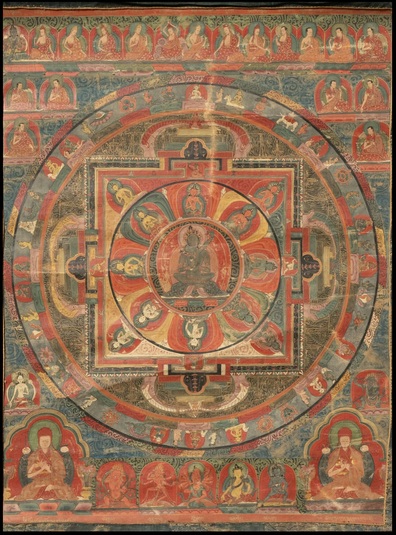
Item: Mandala of Tara (Buddhist Deity) - (Suryagupta, 17 Deity)
| Origin Location | Tibet |
|---|---|
| Date Range | 1500 - 1599 |
| Lineages | Sakya, Ngor (Sakya) and Buddhist |
| Material | Ground Mineral Pigment on Cotton |
| Collection | Private |
Classification: Deity
Tara Seventeen Deity Mandala (Tibetan: drol ma chu dun kyil kor): comprising the Five Buddha Families and consorts, according to the tradition of Suryagupta (Ravigupta).
In the central position, dark green in colour with one face and two hands, the meditational deity Tara gazes forward in a peaceful appearance. The right hand placed at the heart holds a lotus flower and curved knife. The left hand holds to the heart a white skullcup. Both arms embrace the consort. Her long black hair is piled on the crown of the head with some hanging loose across the shoulders. Adorned with a tiara of gold and jewels, large earrings, bracelets and anklets, she embraces the consort Amoghasiddhi Buddha with the two arms. Green in colour with one face and two hands, Amoghasiddhi holds a variously coloured vishvavajra in the left and a gold bell in the right. Adorned with a crown, earrings, necklaces, bracelets and a jeweled girdle, he is locked in an embrace, seated in vajra posture. Above a white moon disc and lotus blossom the couple sits in a sphere of red swirling light encircled by concentric rings.
In the surrounding circle, directly above, is the Amitabha Buddha, red in colour, peaceful, with one face and two hands. The right holds the stem of a lotus flower and the left a gold bell to the heart. Wearing elaborate sambhogakaya vestments he sits in vajra posture. At the right is the consort Pandara Vasini, similar in appearance; holding to the heart a lotus handled curved knife and a skullcup. At the right is Akshobhya Buddha, blue, similar in appearance; holding a gold vajra and bell. Below is the consort Mamaki, blue, similar in appearance; holding to the heart a curved knife and a skullcup, seated in a relaxed posture. Below is Vairochana Buddha, white, holding a wheel and a bell at the side. At the left is the consort Vajradhatvishvari, white, similar in appearance, holding to the heart a wheel handled curved knife and a skullcup, seated in a relaxed posture. At the left is Ratnasambhava Buddha, yellow, holding a jewel and bell. Above is the consort Buddha-Lochani, yellow, holding to the heart a jewel handled curved knife and a white skullcup, seated in a relaxed posture. Each is seated on a moon disc and the inner ring of pink lotus petals, surrounded by variously coloured spheres of light creating the shape of an eight-petalled lotus encircled by a dark blue ring.
Outside of the circle, within the square enclosure are four female attendant deities, yellow Mukunda, red Muraja, green Vamsha and white Vina, all with one face, the two hands placed at the heart and seated in a relaxed posture. At the four doors, 'T' shaped structures, are four female guardian deities. At the left, yellow Varamukha with a pig face; above, red Shvanamukha with a dog face; at the right, white Simhamukha with a lion face; below, white Hayamukha with a horse face. Each has one face and two hands held to the heart, in a standing posture. Each holds a unique hand object.
The outer square enclosure composed of layered strips of colour represent the walls of the celestial palace. The levels of the roof symbolically rise above each of the 'T' shaped doors topped with a Dharma wheel and two reclining deer. The edges of the roof are adorned with upright banners and streamers. The palace sits on a vishvavajra of four colours observed by the tines encircling the roof structures. A multi-coloured lotus with rectangular petals serves as the ground for all. Various worldly deities populate an outer ring, red in colour, and outside of that is the five coloured flames of pristine awareness completely enclosing the fabricated palace structure.
At the top left is Green Tara followed to the right by the teachers of the lineage of the Tara mandala. At the lower left is Ngorchen Konchog Lhundrub (1497-1557 [p783]) with a small White Sita Tara directly above. Following to the right are the Three Great Red Ones - Takkiraja, Kurukulla and Maharakta Ganapati, continuing with Yellow Jambhala, Black Jambhala and the teacher Choje Kunga Lhundrub in the right corner. Directly above is Krodha Nila Achala.
Lineage: Shakyamuni, Arya Tara, Ravigupta, Chandragarbha, Jetari, Vagishvarakirti, Shraddhakaravarma, Tatagata Rakshita, Danashri, Manjushri, Mal Lotsawa, Putser Lotsawa, Ishvarakirti, Dharma Simha, Sthiramati, Gaganakirti, Arya Matidvaja Shribhadra (Chogyal Pagpa, 1235-1280), etc. (Collected Writings of the Great Founding Masters of Sakya, Volume 14. chos rgyal 'phags pa'i bka' 'bum, folio277).
Lineage from Buton Rinchen Drup: Arya Tara, Nagarjuna, Suryagupta, Danashri, Manjushri, Ratnakirta, Kirtidvaja, Punyamurta, Prajnakirta, Shilasthira, Gunamata, Prajna Kumara. (Buton, 1290-1364).
Jeff Watt 1-2019
Buddhist Deity: Green Tara 17 Deity Mandala
Buddhist Deity: Tara (Early Paintings)
Buddhist Deity: Tara Mandalas
Buddhist Deity: Tara Main Page
Buddhist Deity: Tara, Green Main Page

